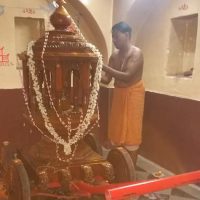History

Toravi Village
4 miles west of Bijapur on the Athani road is Toravi village, which has been known as Twaritalaya since historical times. Shree Laxmi Narasimha devaru fulfills the desires of the devotees quickly, hence it was called as Twaritalaya. It was the capital for some time during the Adil Shahi period.
History Of Sri Narasimha Temple
Looking at the temples cave & sanctum sanctorum it feels that this temple was present even before Muslim ruled this place at the confluence of Toravi and Navaraspura lies the picturesque Sri Narasimha Temple. It has an arched square entrance from the main entrance. In the middle is Sri Tulasi Vrindavan.
A Cave In The
Temple
There is a fortified door in the right-hand south-west corner of the square. Inside is a room with a small shed in front of it. Opposite is the entrance to the cave in the north-east corner. The cave is about 4 feet low, descend into it, turn right, go down two steps, 8-10 feet straight
to the south, turn left again, turn left 2-3 feet, turn left again 5-6 feet, turn right 4-5 feet, and there is a fortified
sanctum sanctorum. The cave is fortified on all sides. It is only wide enough for a man to walk.
Idol Of Sri Lakshmi Narasimha
The idol of Lord Narasimha is a modest 3 feet in height and 2 feet in width. Lord Narasimha is seated on Garuda with his left leg folded and his right leg down and Hiranyakashyapa lying on his lap, slitting his stomach and pulling out his intestines with both hands. The other 6 hands have conch chakra weapons. In the Peeth Prabhavali, there is Sri Lakshmi idol on the right and Prahladaraja idol on the left. At the top there are idols of Matsya , Kurmadi Dashavatara all around. There is a large chakra, from which the idol is expressed as the Saligrama stone.
Shri Narasimha Theertha
About 400 meters to the west of the Sri Narasimha temple is a picturesque reservoir (Bhaivi) on the bank of a stream. This Narasimha Theertha has a tradition that the priests of the Lord bathe in it every day and offer Abhishek to Lord Narasimha from its sanctity. It is believed that the Gupta Ganga is present in this reservoir. Even now, during the period of Kanyagata change in the water quality of this reservoir will be seen .
Lord Shri Narasimha Puja Archana Krama
Priests of Lord Narasimha perform Shodashopachara Puja by reciting Panchasukta and Pavamana Mantra from the holy water of Sri Narasimha Theertha. This is a hereditary procedure. There are two families of priests. For one family, three and a half months of the year (Jeshta, Margashirsha, Magha Masa Purna and Bhadrapada Masa Ardha) are performed and for the other family, the remaining eight and a half months are worshipped. There is a plan of priests of two families of different gotras to facilitate the worship of God.
Shri Narasimha Jayanti And Deepotsava
Every year from Vaishakh Shuddha Ashtami to Vaishakh Pratipade (month of April-May) the festival of Lord Shri Narasimha is celebrated with great pomp. During this period, daily Panchamrita Abhishek, special Deepotsava and Alankara Puja Naivedya Brahmin Anna Santarpana are performed, Special Deepotsava is held on the sunset time of Sri Narasimha Jayanti.Gopala Kavali Utsav will be held on the last day of Vaishakha Pratipada with the singing of Sri Krishna Leela Gana. Then go to Sri Narasimha Teertha with palanquin along with festival idol of Sri Narasimha Devaru and take a bath there. Thousands of devotees get the blessings of Shri Narasimha Devaru during the festival.
Sri Thorave Ramayana Granth
Now famous and specially designated for practice in schools and colleges in Mysore, the book called Sri Toravi Ramayana was composed by a Brahmin poet named Narahari around 1500 CE, sitting in front of the caveman Sri Narasimha God. He has the title of Kumara Valmiki. In the beginning and at the end of the Sri Toravi Ramayana, he has praised Lord Narasimha of Toravi, and in the tenth verse of Balakanda 1st Sandhi he has said that Kumara Valmiki is the author of the book he is creating
